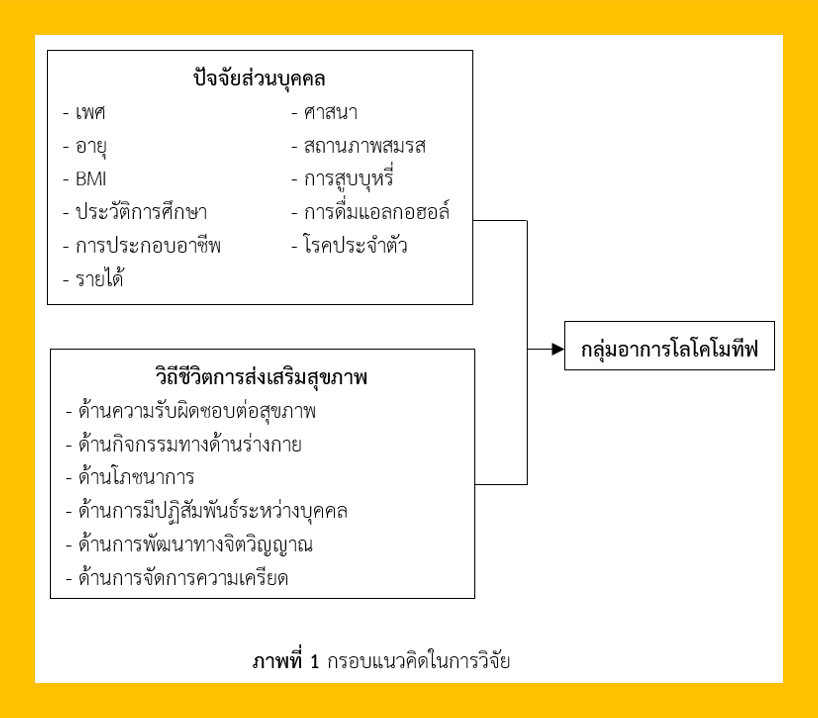ปัจจัยทำนายการเกิดกลุ่มอาการโลโคโมทีฟ ตามวิถีชีวิตการส่งเสริมสุขภาพของผู้สูงอายุที่อาศัยในเขตเมือง
คำสำคัญ:
กลุ่มอาการโลโคโมทีฟ, เขตเมือง, ผู้สูงอายุ, วิถีชีวิตการส่งเสริมสุขภาพบทคัดย่อ
การศึกษาวิจัยแบบ case-control study นี้ มีวัตถุประสงค์เพื่อศึกษาปัจจัยทำนาย ปัจจัยส่วนบุคคล และวิถีชีวิตการส่งเสริมสุขภาพ ต่อการเกิดกลุ่มอาการโลโคโมทีฟในผู้สูงอายุที่อาศัยในเขตเมือง กรุงเทพมหานคร กลุ่มตัวอย่าง คือ ผู้สูงอายุที่เข้ารับบริการแบบผู้ป่วยนอก ห้องตรวจผู้ป่วยนอกออร์โธปิดิกส์ คณะแพทยศาสตร์วชิรพยาบาล มหาวิทยาลัยนวมินทราธิราช จำนวน 200 ราย แบ่งเป็นกลุ่มศึกษา และกลุ่มควบคุม กลุ่มละ 100 ราย เครื่องมือที่ใช้รวบรวมข้อมูล คือ แบบบันทึกข้อมูลส่วนบุคคล และแบบวัดวิถีการดำเนินชีวิตเพื่อการส่งเสริมสุขภาพ – II ฉบับภาษาไทย วิเคราะห์ความเที่ยงโดยใช้ค่าสัมประสิทธิ์แอลฟาของครอนบาค ได้เท่ากับ .93 วิเคราะห์ข้อมูลโดยใช้สถิติเชิงพรรณนา (descriptive statistics) และวิธีการถดถอยแบบโลจิสติคทวิ (binary logistic regression)
ผลการวิจัย พบว่า อายุ ดัชนีมวลกาย ประวัติการศึกษา การสูบบุหรี่ โรคความดันโลหิตสูง โรคเบาหวาน โรคข้อเข่าเสื่อม และวิถีชีวิตการส่งเสริมสุขภาพอยู่ในระดับต่ำถึงปานกลาง เป็นปัจจัยที่สามารถทำนายการเกิดกลุ่มอาการโลโคโมทีฟในผู้สูงอายุ จากผลการศึกษาได้ข้อเสนอแนะ คือ บุคลากรทางการแพทย์ โดยเฉพาะพยาบาลผู้ดูแลผู้สูงอายุ ควรส่งเสริมสุขภาพผู้สูงอายุในการปรับปรุงพฤติกรรมสุขภาพอย่างมีคุณภาพ และสอดคล้องกับวิถีชีวิตประจำวัน โดยเฉพาะอย่างยิ่งในผู้สูงอายุที่เจ็บป่วยด้วยโรคเรื้อรัง เพื่อป้องกันการเกิดผลกระทบจากกลุ่มอาการโลโคโมทีฟ ดำรงไว้ซึ่งภาวะสุขภาพ และคุณภาพชีวิตที่ดีตามศักยภาพ
เอกสารอ้างอิง
Department of Older Persons. Statistics of older persons [Internet]. 2022 [cited 2023 Jan 20]. Available from: https://www.dop.go.th/th/know/side/1/1/1767 (in Thai)
Bureau of Epidemiology. Falling in elderly [Internet]. 2018 [cited 2023 Jan 20]. Available from: www.correct.go.th/meds/index/Download/วป/การพลัดตกหกล้มในผู้สูงอายุ.pdf (in Thai)
Matsumoto H, Hagino H, Wada T, Kobayashi E. Locomotive syndrome presents a risk for falls and fractures in the elderly Japanese population. Osteoporosis and Sarcopenia 2016;2(3):156-63. doi: 10.1016/j.afos.2016.06.001.
Boontham J, Aree-Ue S, Wongvatunyu S, Roopsawang I, Tempaiboolkul T. The relationships among locomotive syndrome, depressive symptom, and quality of life in older adults living in rural areas. Journal of the Medical Association of Thailand 2020;103(8):796-803. doi: 10.35755/jmedassocthai.2020.08.11149.
Nakamura K, Ogata T. Locomotive syndrome: definition and management. Clinical Reviews in Bone and Mineral Metabolism 2016;14(2):56-67. doi: 10.1007/s12018-016-9208-2.
The Japanese Orthopaedic Association. Locomotive syndrome [Internet]. 2015 [cited 2020 Dec 5]. Available from: https://sloc.or.jp/wp01/wp-content/uploads/2018/12/document_2017-05-22-01.pdf
Yoshinaga S, Shiomitsu T, Kamohara M, Fujii Y, Chosa E, Tsuruta K. Lifestyle-related signs of locomotive syndrome in the general Japanese population: a cross-sectional study. Journal of Orthopaedic Science 2019;24(6):1105-9. doi: 10.1016/j.jos.2019.08.005.
Pakholok O. The idea of healthy lifestyle and its transformation into health-oriented lifestyle in contemporary society. SAGE Journals 2013;3(3):1-10. doi: 10.1177/2158244013500281.
Pimmasan B, Janchaiwit P. Family health behavior among hypertension patients at Xiengkhouang provincial hospital Lao People’s Democratic Republic. Journal of Nursing and Health Care 2019;37(1):167-74. (in Thai)
Bureau of Elderly Health, Bureau of Health Promotion, Department of Health Ministry of Public Health. Report health survey of the Thai older persons 2013. Nonthaburi: Wacharin PP Printing; 2013. (in Thai)
Akahane M, Yoshihara S, Maeyashiki A, Tanaka Y, Imamura T. Lifestyle factors are significantly associated with the locomotive syndrome: a cross-sectional study. BMC Geriatrics 2017;17:241. doi: 10.1186/s12877-017-0630-1.
Sinchaiwanichakul C, Kespichayawattana J. Factors related to healthy aging among the older persons in community-dwelling of Bangkok Metropolitan. Journal of The Royal Thai Army Nurses 2018;19 Suppl 1:100-9. (in Thai)
Department of Older Persons (DOP). Statistics of older persons [Internet]. 2019 [cited 2021 Dec 30]. Available from: http://www.dop.go.th/th/know/side/1/1/275 (in Thai)
College of Population Studies, Chulalongkorn University. Quality of life development plan of older persons in Bangkok phase 1 2014-2017. Samut Sakhon: Tanachet; 2014. (in Thai)
Rojpaisarnkit K, Rodjarkpai Y. Well-being of the elderly living in urban and rural areas of Thailand. The Public Health Journal of Burapha University 2018;13(1):113-27. (in Thai)
Saengngoen S, Maton T. Comparisons of quality of life among the elderly in urban, semi-urban and rural communities in Sukhothai province, Thailand. Thai Journal of Public Health 2018;48(2):174-84. (in Thai)
Pender NJ, Murdaugh CL, Parsons MA. Health promotion in nursing practice. 7th ed. New Jersey: Pearson; 2014.
Kelsey JL, Whittemore AS, Evans AS, Thompson WD. Methods in observational epidemiology. Oxford: Oxford University; 1996.
Shingo M, Hirano K. Development of a convenient way to predict ability to walk, using a two-step test. Journal of The Showa Medical Association 2003;63(3):301-8. doi: 10.14930/jsma1939.63.301.
Trongsakul S. Correlation between cognitive impairment and depressive mood of Thai elderly with type 2 diabetes in a primary care setting. Malaysian Family Physician 2015;10(1):11-8.
Seeherunwong A, Suwonnaroop N. An analysis of validity and reliability of the health-promoting lifestyle profile-II in Thai version. The Journal of Thailand Nursing and Midwifery Council 2004;19(4):44-63. (in Thai)
Hirano K, Imagama S, Hasegawa Y, Wakao N, Muramoto A, Ishiguro N. Impact of spinal imbalance and back muscle strength on locomotive syndrome in community-living elderly people. Journal of Orthopaedic Science 2012;17(5):532-7. doi: 10.1007/s00776-012-0266-0.
Nakamura M, Kobashi Y, Hashizume H, Oka H, Kono R, Nomura S, et al. Locomotive syndrome is associated with body composition and cardiometabolic disorders in elderly Japanese women. BMC Geriatrics 2016;16:166. doi: 10.1186/s12877-016-0339-6.
Ohtsuki M, Nishimura A, Kato T, Sokejima S, Shibata T, Okada H, et al. Relationships between body mass index, lifestyle habits, and locomotive syndrome in young-and middle-aged adults: a cross-sectional survey of workers in Japan. Journal of Occupational Health 2019;61(4):311-9. doi: 10.1002/1348-9585.12053.
Sugai K, Imamura H, Michikawa T, Asakura K, Nishiwaki Y. Awareness of locomotive syndrome and factors associated with awareness: a community-based cross-sectional study. International Journal of Environmental Research and Public Health 2020;17(19):7272. doi: 10.3390/ijerph17197272.
Yoshimura N, Muraki S, Oka H, Tanaka S, Kawaguchi H, Nakamura K, et al. Mutual associations among musculoskeletal diseases and metabolic syndrome components: a 3-year follow-up of the ROAD study. Modern Rheumatology 2015;25(3):438-48. doi: 10.3109/14397595.2014.972607.
Musumeci G, Aiello FC, Szychlinska MA, Rosa DM, Castrogiovanni P, Mobasheri A. Osteoarthritis in the XXIst century: risk factors and behaviours that influence disease onset and progression. International Journal of Molecular Sciences 2015;16(3):6093-112. doi: 10.3390/ijms16036093.
Yoshihara T, Ozaki H, Nakagata T, Natsume T, Kitada T, Ishihara Y, et al. Association between locomotive syndrome and blood parameters in Japanese middle-aged and elderly individuals: a cross-sectional study. BMC Musculoskeletal Disorders 2019;20:104. doi: 10.1186/s12891-019-2480-9.
Ohsawa T, Yanagisawa S, Shiozawa H, Omodaka T, Saito K, Kitagawa T, et al. Relationship between knee osteoarthritis and the locomotive syndrome risk tests: a cross-sectional study. Journal of Orthopaedic Science 2016;21(4):512-6. doi: 10.1016/j.jos.2016.03.011.
Sylwander C, Sunesson E, Andersson MLE, Haglund E, Larsson I. Experiences of health-promoting activities among individuals with knee pain: the Halland osteoarthritis cohort. International Journal of Environmental Research and Public Health 2022;19(17):10529. doi: 10.3390/ijerph191710529.

ดาวน์โหลด
เผยแพร่แล้ว
รูปแบบการอ้างอิง
ฉบับ
ประเภทบทความ
สัญญาอนุญาต
ลิขสิทธิ์ (c) 2023 วารสารเกื้อการุณย์

อนุญาตภายใต้เงื่อนไข Creative Commons Attribution-NonCommercial-NoDerivatives 4.0 International License.














